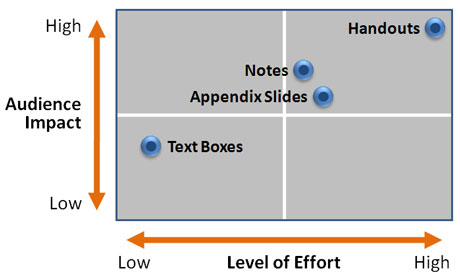Many presentation experts recommend keeping your PowerPoint slides as simple as possible. How do you balance keeping your slides simple with providing your audience with ample information? On one hand, you don’t want to necessarily pack your business presentation with too much information leading to a death by PowerPoint experience for your audience. On the other hand, you worry about providing insufficient details for them to deeply understand your topic and apply what they learned. I will review four different tactics that you can use to overcome this challenge:
- Handouts
- Notes
- Appendix slides
- Text boxes
Handouts
You can prepare a detailed document to leave behind as a handout after your presentation. Rather than inundating your audience with all the minutiae of your topic in your slides (i.e., charts, tables, diagrams, etc.), you can focus your PowerPoint presentation on the most salient points. Garr Reynolds of Presentation Zen fame is an advocate of this approach. Although preparing handouts is a great way to simplify your PowerPoint slides, it isn’t always practical for everyday presentations. Most presenters struggle to prepare their slides in time, let alone a more detailed companion document. Depending on how much time you have to prepare, this option may or may not make sense.

This graph compares the different options on two axes: level of effort and audience impact.
Notes
You can simplify your slides by removing some of the details and putting them in the notes section. A detailed notes section serves dual purposes. It is a useful tool for rehearsing your slides, and it can be leveraged as an improvised handout. Although it takes some work to prepare detailed notes for your slides, it will take less time than preparing an entirely separate handout document.
Appendix Slides
Just because slides are in your PowerPoint presentation, it doesn’t mean you have to present them. You can have additional detailed slides in an appendix or “parking lot” within your PowerPoint slide deck. If your audience is interested in more details, you can jump to the supporting data during your presentation. If you feel your audience may need more detailed reference material after you have presented, you can include the appendix slides in a handout version of your PowerPoint slides. While notes and appendix slides won’t replace a well-designed handout document, they can help to bridge any post-presentation knowledge gap.
Text Boxes
As a consultant, I find that busy executives do not always have time to review the notes sections of PowerPoint presentations. Strategically placed text boxes in a smaller font than the body text can be used to highlight key points or takeaways and can be quickly scanned by executives after the slides have been presented. This tactic is more suited to everyday business presentations than “big event” presentations such as PowerPoint slides for an industry conference. It may not adhere to a rigid simplicity rule, but text boxes can help to blend selected low-level details with an overall simplified approach.
If you have another approach which helps to balance simplicity with detail, please drop me a line about it. PowerPoint ninjas always seek greater presentation enlightenment.

